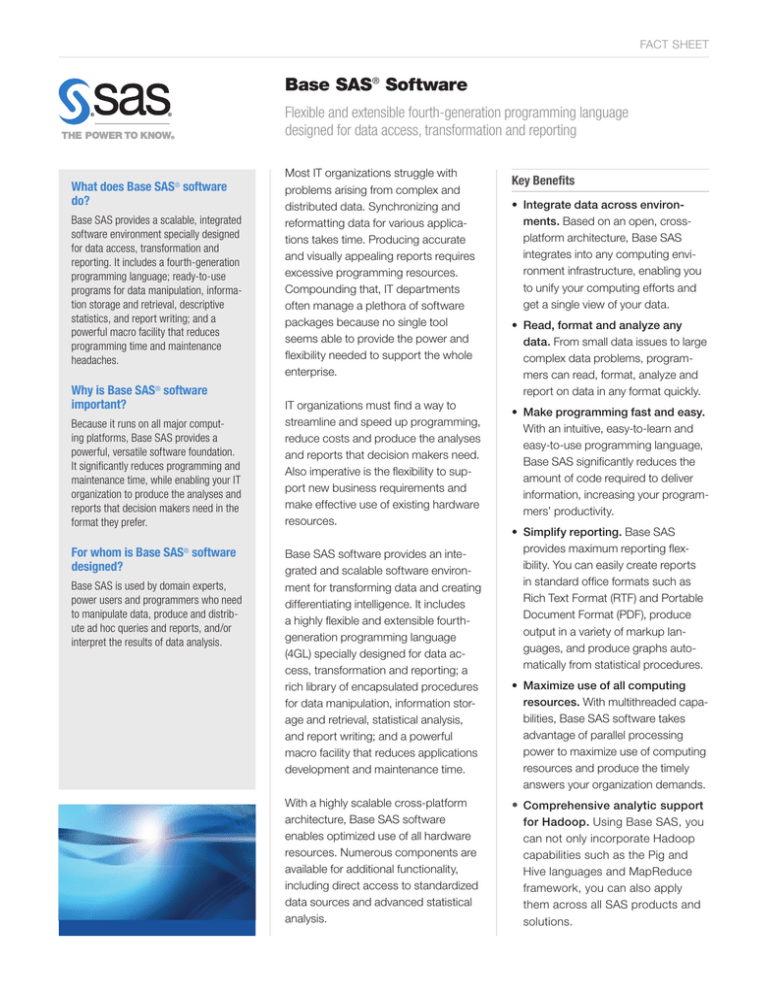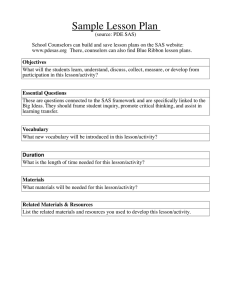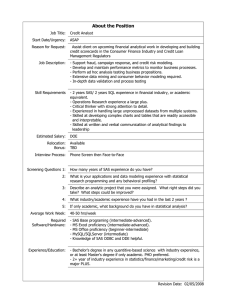
FACT SHEET
Base SAS® Software
Flexible and extensible fourth-generation programming language
designed for data access, transformation and reporting
What does Base SAS® software
do?
Base SAS provides a scalable, integrated
software environment specially designed
for data access, transformation and
reporting. It includes a fourth-generation
programming language; ready-to-use
programs for data manipulation, information storage and retrieval, descriptive
statistics, and report writing; and a
powerful macro facility that reduces
programming time and maintenance
headaches.
Why is Base SAS® software
important?
Because it runs on all major computing platforms, Base SAS provides a
powerful, versatile software foundation.
It significantly reduces programming and
maintenance time, while enabling your IT
organization to produce the analyses and
reports that decision makers need in the
format they prefer.
For whom is Base SAS software
designed?
®
Base SAS is used by domain experts,
power users and programmers who need
to manipulate data, produce and distribute ad hoc queries and reports, and/or
interpret the results of data analysis.
Most IT organizations struggle with
problems arising from complex and
distributed data. Synchronizing and
reformatting data for various applications takes time. Producing accurate
and visually appealing reports requires
excessive programming resources.
Compounding that, IT departments
often manage a plethora of software
packages because no single tool
seems able to provide the power and
flexibility needed to support the whole
enterprise.
IT organizations must find a way to
streamline and speed up programming,
reduce costs and produce the analyses
and reports that decision makers need.
Also imperative is the flexibility to support new business requirements and
make effective use of existing hardware
resources.
Base SAS software provides an integrated and scalable software environment for transforming data and creating
differentiating intelligence. It includes
a highly flexible and extensible fourthgeneration programming language
(4GL) specially designed for data access, transformation and reporting; a
rich library of encapsulated procedures
for data manipulation, information storage and retrieval, statistical analysis,
and report writing; and a powerful
macro facility that reduces applications
development and maintenance time.
With a highly scalable cross-platform
architecture, Base SAS software
enables optimized use of all hardware
resources. Numerous components are
available for additional functionality,
including direct access to standardized
data sources and advanced statistical
analysis.
Key Benefits
• Integrate data across environments. Based on an open, crossplatform architecture, Base SAS
integrates into any computing environment infrastructure, enabling you
to unify your computing efforts and
get a single view of your data.
• Read, format and analyze any
data. From small data issues to large
complex data problems, programmers can read, format, analyze and
report on data in any format quickly.
• Make programming fast and easy.
With an intuitive, easy-to-learn and
easy-to-use programming language,
Base SAS significantly reduces the
amount of code required to deliver
information, increasing your programmers’ productivity.
• Simplify reporting. Base SAS
provides maximum reporting flexibility. You can easily create reports
in standard office formats such as
Rich Text Format (RTF) and Portable
Document Format (PDF), produce
output in a variety of markup languages, and produce graphs automatically from statistical procedures.
• Maximize use of all computing
resources. With multithreaded capabilities, Base SAS software takes
advantage of parallel processing
power to maximize use of computing
resources and produce the timely
answers your organization demands.
• Comprehensive analytic support
for Hadoop. Using Base SAS, you
can not only incorporate Hadoop
capabilities such as the Pig and
Hive languages and MapReduce
framework, you can also apply
them across all SAS products and
solutions.
Product Overview
Base SAS software is a highly flexible
and integrated software environment
that can be used in virtually any setting
to access, manipulate, manage, store,
analyze and report on data.
cal analysis and report writing. They
encapsulate and deliver significant
functionality that can be executed with
just a few simple commands, enabling
programmers to be more efficient and
productive.
Powerful data analysis tools
Key Capabilities
Intuitive fourth-generation
programming language
Base SAS provides a highly flexible
and extensible 4GL with an easy-tolearn syntax and hundreds of language
elements and functions that support
programming everything from data
extraction, formatting and cleansing to
data analysis, reporting and information
delivery.
A rich library of prewritten, ready-to-use
integrated procedures
Prewritten SAS procedures handle
many common tasks, including data
manipulation and management, information storage and retrieval, statisti-
Base SAS can be used for a wide
variety of analyses ranging from simple
descriptive statistics that include mean,
sum, variance and standard deviation
to more advanced data correlation and
cross-correlation, frequency analysis
and detailed data distribution analysis.
SAS® macro facility
Included as part of the SAS language,
the SAS macro facility lets you extend
and customize your SAS programs by
reducing the amount of coding required
for common tasks. With the macro
facility, you encapsulate small or large
amounts of text into units with names
and then work with the names rather
than the longer text. Your development
staff can modularize its work for easy
reuse and maintenance.
SAS® Code Analyzer
The SAS Code Analyzer runs an
existing SAS program, executing the
program as usual, while generating metadata about the SAS job that
is emitted via comments. The SAS
Code Analyzer can be used to capture
information such as file dependencies
and macro symbol usage to assist in
analysis and potential modification of
legacy SAS programs.
In-database capabilities
Some of the most widely used Base
SAS procedures now support SQL
push-down capabilities to the following third-party databases: Aster Data,
Greenplum, IBM DB2, Netezza, Oracle
and Teradata. SAS users can continue
to program as usual, but SAS converts
their code into database SQL-specific
code optimized to the receiving database. SAS procedures currently
supporting SQL push-down optimization are FREQ, MEANS, RANK,
REPORT, SORT, SUMMARY and
TABULATE. In addition, SAS format
catalogs can be published and compiled inside those databases. This allows
formats to be applied to the actual data
values during query execution, reducing data movement.
Cross-platform and multiple-platform
support
With MultiVendor Architecture™,
Base SAS runs on all major computing
platforms, can access virtually any data
source and easily integrates into any
organization’s computing environment.
SAS code developed on one platform
runs easily on others.
Support for symmetric multiprocessing
(SMP) hardware
Base SAS capabilities can be extended with additional components such as SAS/GRAPH ®
software for advanced graphic capabilities.
Key SAS procedures for sorting, querying and summarizing data are threaded,
enabling them to take advantage of
multi-CPU computing environments.
The SAS Scalable Performance
Data Engine speeds throughput and
processing of very large data sets by
employing parallel read and indexing
capabilities on partitioned SAS data
sets.
SAS® Open Metadata Architecture
Base SAS delivers the SAS Open Metadata Architecture, a general purpose
metadata management facility that
provides common metadata services
to SAS and other applications. The
SAS Metadata Server allows business
metadata to be shared across the
enterprise from a centralized repository,
ensuring that metadata is consistent,
accurate and not held in isolated, hardto-maintain silos.
SAS® Management Console
Managing a variety of applications
across different platforms can be timeconsuming. The SAS Management
Console is a Java framework that provides a single interface for easier management of many SAS administrative
tasks. Whether your SAS deployment is
across multiple platforms, departments
or the entire enterprise, the easy-to-use
GUI enables IT professionals to more
effectively manage and administer all
aspects of SAS. Site-specific tasks are
supported with customizable plug-ins.
SAS® XML Mapper
The XML engine delivered with Base
SAS imports and exports a wide variety
of XML documents. For complex XML
documents, a new Java client simplifies
the handling of nonstandard tags. The
SAS XML Mapper provides a dragand-drop interface for creating reusable
XML maps, which describe an XML
document’s content or type and tell the
XML engine how to convert the XML
document into SAS data sets, variables
(columns) and observations (rows).
Key Features
Flexible 4GL
• Intuitive 4GL with easy-to-learn syntax.
• SAS Macro Facility reduces coding for common tasks and lets you modularize work for easy
reuse and maintenance.
• Runs interactively or in batch mode.
Powerful data analysis capabilities
• Analysis capabilities ranging from simple descriptive statistics to advanced data correlations.
• Library of prewritten programming procedures for managing, analyzing and presenting data.
Support for wide range of data formats
• Ability to read data in any format, from any kind of file, including variable-length records, binary
files, free-formatted data and even files with messy or missing data.
• Support for Structured Query Language (SQL).
• Globalization with full support for the most widely used character encodings (such as Latin1,
Latin2, and multiple-byte character sets for Hebrew, Arabic and Asian languages).
• Unicode support so that SAS works with data in multiple languages on all platforms.
Support for Hadoop
• Support for Pig, MapReduce and HDFS commands from the SAS execution environment.
• Supports external file references from within any SAS component. Delimiters are externalized,
making it easy to work with Hadoop files.
Performance and scalability
• Parallel I/O optimization lets you work with huge data volumes in a timely manner. Data can be partitioned across devices for faster access but referenced as a single data set.
• Parallel index creation reduces time needed to create large data sets with multiple indexes or to append data to existing data sets.
• Key SAS procedures are multithreaded for faster execution of standard tasks such as sorting
and data summarization.
• Base SAS scalability can be enhanced to span multiple machines and networks using SAS/CONNECT® software, which is available separately.
• Several Base SAS procedures support SQL push-down optimization to Aster Data, EMC Greenplum, IBM DB2, Netezza, Oracle and Teradata.
• SAS format catalogs can be published and compiled inside databases (Aster Data, EMC Greenplum, IBM DB2, Netezza, Oracle and Teradata) so that formats can be applied to the
actual data values during query execution.
Interoperability and multiple-platform deployment
• MultiVendor Architecture allows programs to be written once and run anywhere, regardless of
hardware or operating system.
• SAS Open Metadata Architecture enables different applications to exchange metadata.
• The GROOVY procedure enables SAS code to execute on the Java Virtual Machine.
• Cross-environment data access provides easy-to-access files across a network.
Manageability
• SAS Management Console provides an extensible Java GUI for administering SAS tasks.
• XML engine imports and exports a wide variety of XML documents. A drag-and-drop interface
creates XML maps.
• Checkpoint and restart capability allows users to resubmit a failed program in restart mode to
complete execution, resuming with the step that did not complete when the failure occurred.
• Application Response Measurement (ARM) interface monitors the availability and performance
of transactions within and across diverse applications.
Continued on next page
Output Delivery System (ODS)
The Output Delivery System for
data capture, report formatting and
information delivery provides an almost
limitless number of choices for reporting and displaying analytical results
with a wide variety of output formats
and destinations. While providing an
array of options for customizing the
output, ODS takes care of arranging
the output in the form most appropriate
for the chosen format. Programmers
can create and deliver accurate and
visually appealing reports in less time
with reduced effort. With ODS statistical
graphics, a statistical procedure generates appropriate graphical displays for
its analyses by default.
Key Features (continued)
Data presentation
• ODS provides choices for reporting and displaying analytical results.
• High-quality graphics are now included in Base SAS (ODS Statistical Graphics, the SG family of
procedures, the Graphical Template Language, the ODS Graphics Designer and the ODS Graphics Editor).
• Create reports in standard formats such as RTF and PDF. All formats are available on all
platforms.
• Create visually appealing graphics from analytic output by default (no additional programming).
• HTML 4 and XML are among the markup languages provided. Modify any markup language
that SAS provides or create your own markup language for output. HTML is the default destination for output.
• Customize or modify output hierarchy; replay output to different destinations without rerunning
the program.
Base SAS® System Requirements
To learn more about Base SAS
system requirements, download
white papers, view screenshots and
see other related material, please
visit sas.com/basesas.
SAS Institute Inc. World Headquarters +1 919 677 8000
To contact your local SAS office, please visit: www.sas.com/offices
SAS and all other SAS Institute Inc. product or service names are registered trademarks or trademarks of SAS Institute Inc. in the USA
and other countries. ® indicates USA registration. Other brand and product names are trademarks of their respective companies.
Copyright © 2012, SAS Institute Inc. All rights reserved. 101198_S88296.0312



